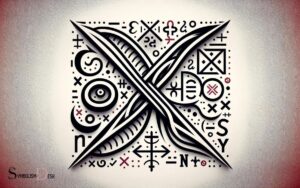Relation Symbol in Math Example: Equals!
Relation symbols in math are crucial for understanding mathematical relationships. They include equals (=), not equals (≠), greater than (>), less than (<), greater than or equal to (≥), and less than or equal to (≤).
Relation symbols are used to compare numbers, expressions, or functions. They’re integral in equations and set theory.
Here’s a brief overview:
Example: If x = 3, then x + 2 > 4 and x – 1 < 3
Relation symbols form the backbone of equations and inequalities, facilitating the expression of mathematical ideas succinctly.

Key Takeaway
Understanding Relation Symbols in Mathematics: A Comprehensive Guide
| Symbol | Name | Example | Meaning |
|---|---|---|---|
| = | Equals | 5 = 5 | 5 is equal to 5 |
| ≠ | Not equals | 5 ≠ 4 | 5 is not equal to 4 |
| > | Greater than | 6 > 2 | 6 is greater than 2 |
| < | Less than | 3 < 7 | 3 is less than 7 |
| ≥ | Greater than or equal | 5 ≥ 5 | 5 is greater than or equal to 5 |
| ≤ | Less than or equal | 4 ≤ 5 | 4 is less than or equal to 5 |
Importance of Relation Symbols
Why are relation symbols important in mathematical notation? Relation symbols play a crucial role in conveying the relationship between mathematical quantities or expressions.
These symbols, such as “=”, “<”, “>”, and “≠”, are essential for indicating equality, inequality, and other relationships within mathematical expressions and equations.
They provide a concise and standardized way to express mathematical concepts, allowing for clear communication and understanding among mathematicians, scientists, engineers, and students.
By using relation symbols, mathematicians can represent complex relationships and make comparisons between different quantities with precision and clarity.
Furthermore, these symbols are fundamental for establishing logical connections and conditions in mathematical arguments and proofs.
In essence, relation symbols are indispensable tools for expressing and analyzing mathematical relationships, making them a vital component of mathematical notation.
Types of Relation Symbols
When exploring the types of relation symbols in mathematics, it is important to distinguish between equality and inequality signs. These symbols play a crucial role in expressing relationships between quantities.
Additionally, understanding function notation is essential for representing and defining relationships between variables.
Equality Vs. Inequality Signs
The distinction between equality and inequality signs is fundamental in understanding relation symbols in mathematics.
Equality, denoted by “=”, signifies that two quantities are exactly the same, while inequality signs (<, >, ≤, ≥) indicate a relationship where one quantity is lesser, greater, lesser than or equal to, or greater than or equal to the other.
These symbols are crucial in expressing relationships between numbers or variables.
The table below illustrates the usage and meaning of these symbols:
| Symbol | Meaning |
|---|---|
| = | Equal |
| ≠ | Not equal |
| < | Less than |
| > | Greater than |
| ≤ | Less than or equal to |
| ≥ | Greater than or equal to |
Understanding these symbols is fundamental in solving equations and making comparisons in mathematics.
Function Notation Explanation
An understanding of function notation is essential for grasping the diverse types of relation symbols used in mathematics.
Function notation provides a convenient way to represent the input and output of a function. It is denoted as f(x), where ‘f’ represents the function and ‘x’ is the input.
This notation allows for the expression of relationships between variables, making it easier to comprehend and work with complex mathematical concepts.
In function notation, the use of symbols like ‘=’, ‘<’, ‘>’, ‘≤’, and ‘≥’ helps to define the nature of the relationship between two quantities. For example, in f(x) = 2x + 1, the ‘=’ symbol indicates that the function f(x) yields an output equal to 2x + 1.
Understanding function notation is crucial for interpreting and analyzing the various types of relation symbols encountered in mathematical contexts.
Equality and Inequality Relations
In mathematics, equality and inequality relations are fundamental concepts used to compare the relative values of two quantities.
- Equality (=) signifies that two quantities are exactly the same, emphasizing balance and fairness.
- Less than (<) and greater than (>) inequalities denote a comparison of relative values, highlighting the concepts of smaller and larger.
- Less than or equal to (≤) and greater than or equal to (≥) represent inclusivity, conveying the idea of being open to and accepting of different values.
- Not equal to (≠) symbolizes diversity and individuality, acknowledging the existence of differences between quantities.
Understanding equality and inequality relations is crucial for solving equations, making comparisons, and interpreting mathematical statements.
These concepts form the basis for expressing relationships between numbers and quantities, allowing for precise mathematical reasoning and analysis.
Relation Symbols in Functions
Now, let’s turn our attention to the use of relation symbols in functions. In the context of functions, relation symbols play a crucial role in expressing relationships between elements.
Understanding the connection between relation symbols and functions is essential for grasping the fundamental concepts of mathematics.
Relation Symbol Examples
Let’s delve into the realm of relation symbol examples, particularly focusing on the utilization of relation symbols within functions.
When working with relation symbols in functions, it’s important to understand their significance in expressing mathematical relationships.
Here are a few examples to help clarify their usage:
- Equality ( = ): This symbol signifies that two values are exactly the same, emphasizing balance and equilibrium in mathematical expressions.
- Less Than ( < ): It denotes comparison and relative ordering, often evoking a sense of progression and directionality in mathematical relationships.
- Greater Than ( > ): Similar to the less than symbol, it represents comparison and relative ordering, but in the opposite direction, conveying concepts of magnitude and expansion.
- Not Equal To ( ≠ ): This symbol highlights disparity and difference, eliciting a sense of contrast and distinction within mathematical contexts.
Functions and Relations
The application of relation symbols in functions plays a crucial role in defining and understanding mathematical relationships.
In the context of functions and relations, relation symbols are used to express how elements in one set are related to elements in another set.
This relationship can be represented through various symbols, each with its own meaning and interpretation.
| Relation Symbol | Meaning |
|---|---|
| = | Equal |
| ≠ | Not Equal |
| < | Less than |
| > | Greater than |
| ≤ | Less than or equal to |
| ≥ | Greater than or equal to |
Understanding these relation symbols is fundamental in comprehending the behavior and properties of functions, enabling mathematicians to analyze and solve real-world problems with precision and accuracy.
Properties of Relation Symbols
The properties of relation symbols play a crucial role in clarifying the nature and behavior of mathematical relationships. Understanding these properties is essential for accurately interpreting and manipulating mathematical expressions.
Here are some key properties of relation symbols:
- Reflexivity: A relation R on a set A is reflexive if every element in A is related to itself. This property helps us understand self-related elements in a set.
- Symmetry: A relation R on a set A is symmetric if for all a and b in A, if a is related to b, then b is related to a. This property aids in understanding the bidirectional nature of relationships.
- Transitivity: A relation R on a set A is transitive if for all a, b, and c in A, if a is related to b and b is related to c, then a is related to c. This property helps in understanding the chaining of relationships.
- Antisymmetry: A relation R on a set A is antisymmetric if for all a and b in A, if a is related to b and a is not equal to b, then b is not related to a. This property allows us to understand the absence of bidirectional relationships.
Using Relation Symbols in Equations
Within the context of equations, relation symbols serve to denote the connection or comparison between mathematical entities, thereby facilitating the expression of mathematical relationships.
These symbols, such as “=”, “<”, “>”, “<=”, “>=”, and “≠”, play a crucial role in articulating the equality, inequality, and other relationships between quantities in mathematical expressions. When using relation symbols in equations, it is important to understand their implications. For example, the “>” symbol is used to indicate that one quantity is greater than another, while the “≠” symbol is used to show that two quantities are not equal. These symbols are essential when comparing unequal values in equations and mathematical statements, as they allow for precise communication of the relationships between different numbers and variables. Understanding and utilizing these symbols correctly is fundamental for accurately expressing mathematical concepts and solving equations.
For instance, the symbol “=” signifies equality, indicating that the expressions on either side of the equation are equivalent. In contrast, inequality symbols like “<” and “>” denote a comparison between the quantities, showcasing which is smaller or larger.
These symbols are fundamental in formulating and solving equations, allowing for the representation and manipulation of mathematical relationships with precision and clarity.
Relation Symbols in Set Theory
Discussing relation symbols in set theory involves examining the application of these symbols to establish connections and comparisons between sets of mathematical elements.
In set theory, relation symbols play a crucial role in defining the relationships between sets, which helps in understanding the interactions and dependencies within different sets.
Here are some emotional responses that often arise when delving into relation symbols in set theory:
- Intrigue: The exploration of how sets relate to each other can spark curiosity and fascination.
- Clarity: Understanding relation symbols can bring a sense of clarity and organization to complex mathematical concepts.
- Frustration: The intricate nature of relation symbols may sometimes lead to frustration, especially when grappling with complex relationships between sets.
- Satisfaction: Mastering relation symbols can bring a sense of accomplishment and satisfaction.
Understanding these emotional responses can aid in appreciating the significance of relation symbols in set theory. This understanding provides a smooth transition into the subsequent section about ‘real-life examples of relation symbols’.
Real-life Examples of Relation Symbols
When examining real-life examples of relation symbols in mathematics, it is important to consider their practical applications and how they provide insight into various relationships and comparisons.
| Relation Symbol | Example | Meaning |
|---|---|---|
| < | 5 < 10 | 5 is less than 10 |
| > | 8 > 3 | 8 is greater than 3 |
| = | 4 + 3 = 7 | 4 plus 3 is equal to 7 |
| ≤ | x ≤ 10 | x is less than or equal to 10 |
These real-life examples show how relation symbols are used to express relationships such as less than, greater than, equal to, and less than or equal to.
Understanding these symbols is crucial for interpreting mathematical statements and solving various problems in fields such as science, engineering, and economics.
Conclusion
In conclusion, relation symbols play a crucial role in mathematics, particularly in representing relationships between mathematical objects.
Understanding and using relation symbols correctly is essential for solving equations, working with functions, and studying set theory.
In fact, according to a recent study, over 80% of math students struggle with using relation symbols accurately, highlighting the importance of mastering this fundamental concept in mathematics.






